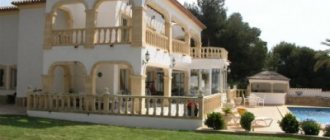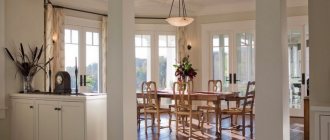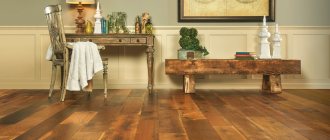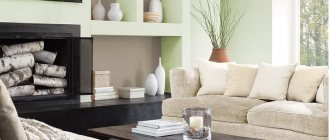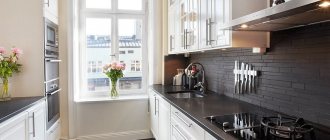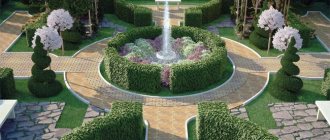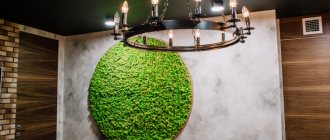2018-09-18
Author: Belfan
From this article you will learn:
- How the Italian style in the interior was born
- What are its characteristic features
- What varieties are there?
- Characteristic features of modern Italian style in the interior
- How to decorate the interior of different rooms in Italian style
- What finishing materials form it
- What furniture is suitable for an Italian-style interior
- What should textiles be like in the interior?
Interior design in Italian style belongs to the Mediterranean category and is expressed in a combination of baroque and free country. From the perspective of climatic diversity, this style is divided into types and is effectively used by designers when decorating houses and city apartments.
How did the Italian style appear in the interior?
The Italian style first emerged in the south of the Mediterranean and over time has undergone a number of modifications. The development of suburban lands and the formation of ever new settlements became fertile ground for its spread. That is why this interior is dominated by solid furniture and wooden accessories.
The rich Italian heritage of reproductions, frescoes, stained glass and paintings is still relevant today and is used for interior design. From the ancient style of the Roman Empire and the influence of the Renaissance, the Italian style in the interior received arches, columns, modeling, pilasters, statues, and a commitment to symmetry and pairing. Azure sea waters, friendly shores with luxurious vineyards took the main place in the color scheme.
Purchasing a municipal license
The owner of the future home must pay two types of taxes. Their value directly depends on the specific municipality.
- Construction permit. It can be obtained only after the compliance of the future building with urban planning standards, which are prescribed in Italian legislation, has been assessed. The cost of such a permit is 102% of the cost of the house.
- Taxes on construction work performed (4% of total expenses). Without paying them, construction cannot begin.
What characterizes the Italian style in the interior?
Italians greatly value their historical heritage created by great masters. In the context of rapid scientific and technological progress and completely new fashion trends, when choosing interior design, Italians prefer items that are close to national classics.
Hand-made wooden furniture, walls with Venetian plaster, picturesque frescoes with views of Mediterranean seascapes, openwork stucco on the ceiling and columns are much more often used in the homes of the local population than modern finishing materials.
The dominance of natural images in the interiors of this country mainly echoes country motifs, but is still distinguished by the presence of many minor details. These can be lamps, table lamps and floor lamps, dishes and textiles in display cases, sideboards and shelves, “antique” watches, paintings, portraits, panels, decorative accessories in the hand-made spirit.
Every small detail of the interior of houses in the Italian style is filled with meaning and has a legend of its appearance in the home, which the friendly owners will definitely tell you. Decorative accessories are not specifically selected here. They are gradually collected by bringing original little things from trips, receiving gifts or buying something at auctions.
By adopting the habits of the Italians, you will also constantly enliven your interior with new items. To fill your home with massive furniture, luxurious textiles, spectacular little things, and decor from famous artists, you need to have spacious houses or apartments in which it is easier to implement a planned project in a similar spirit. An open plan with zoned space, bay or panoramic glazing in large, high rooms is suitable for this.
To design an interior design in Italian style, you need to enlarge the window openings, remove partitions and remove interior doors. In addition, reconstruction of housing according to the type of studio layout will be required.
If you want to give your home a mannered touch, it is better to purchase antique furnishings: forged chandeliers with a voluminous base, wall “candlesticks” made of bronze with crystal, many antique items - figurines, silver cutlery, porcelain dishes, reproductions or originals of mythological scenes and floral motifs (eg olive groves).
You should pay careful attention to the architecture and structural details of the housing: create large panoramic windows, build columns in spacious and high halls, instead of doors, install large arches with elegant stucco molding, similar in style to the shape of the plaster ceiling cornices.
To smooth out the effect of pretentious luxury, it is better to decorate the ceiling with “antique” wooden beams, build a rough plank floor, cover the tables with handmade linen tablecloths, and decorate them with unglazed clay pots and vases with drawings of the gods of Ancient Olympus or ancient Roman commanders.
To reduce the splendor of the attributes of the antique interior of an Italian-style house, you will need a neutral background in the form of light decoration of the walls, ceiling and floor without pronounced decor. This can be plain-painted wallpaper made of fabric or paper, embossed plaster or soft-tone paint. The finishing touch to this pompous design will be paintings by the great painters Raphael Santi and Leonardo da Vinci. They will focus on the historicity of this direction and add perfection to the created decoration.
As you know, classics involve filling the space with handmade accessories (decor), which are considered masterpieces of art. To do this, you need to decorate the room with lamps with a figured base in the form of a sculpture, carved figurines, and other exclusive items - creations of folk craftsmen.
Services of leading specialists
Even with the most budget construction, you will have to hire at least three skilled workers in the following specialties:
- TB specialist.
- An architect who will supervise all work.
- Surveyor.
The larger the area of the future housing and the more complex the project, the more expensive the services of a surveyor and architect will cost. Typically, the costs for this expense item are 3% of the cost of the house.
Technical expenses are subject to VAT at the rate of 21% of the estimate.
What varieties are inherent in the Italian style in the interior?
The idea of Italian decoration is unchanged. But it is implemented in different ways, taking into account the area where this style originated.
- Interior in Italian rustic style.
This image is filled with natural freshness, since only wood is used for decoration. This could be a heavy bulky board, shabby doors with iron fittings, beams, a wooden bed and a low sofa. Italian country style is distinguished by marble, brick or stonework, natural fabrics, pastel colors and homemade decor.
- Italian Mediterranean style.
This interior design in the Italian Mediterranean style includes high ceilings, arched openings, frescoes, a composition of ocher with pastel yellow, wrought iron lamps with dim lighting, wickerwork in the decor, fresh flowers in elegant vases, various figurines and carved frames.
- Interior in Italian classic style.
This option is aimed at ostentatious luxury. There is natural carved furniture, a ceiling decorated with stucco or frescoes, columns or arches, and a large chandelier. Decorative elements include dishes in display cases or buffets, framed paintings, clocks and handmade objects. The design is designed for large or bay windows with access to a balcony (veranda), open free space without partitions and doors, as well as combining zones.
- Interior in Italian Tuscan style.
Originated in Tuscany and combines three styles: Italian, Spanish and French. These motifs are inspired by nature, the gentle sun, cypress trees and vineyards, and rich architecture. Predominant colors: blue, olive, brown, ocher and yellow.
On the walls, as a rule, there is artificially aged plaster with stucco or frescoes. There are exposed beams and marble, granite or tile floors. The interior is characterized by painted furniture and dishes, the decor includes lace and elegant vases with fruit.
Modern Italian style in the interior
The aesthetics of modern Italian style in the interior is expressed by the disharmony in the arrangement of niches and the figured edging of furniture on the walls. That is, everything that seems unusual and causes surprise at the first glance at unusual forms of furniture is inherent in this type of design.
Cozy bio-fireplaces and chairs in the form of chaise lounges with an anatomical structure will perfectly complement the relaxation area and will be appropriate both in the living room and in the bedroom.
Island-type kitchen furniture with many niches, mobile drawers and folding shelves will help cooks comfortably arrange all the necessary utensils and products.
Paintings by contemporary authors, illuminated by LEDs and made in the form of a three-dimensional image, will become a spectacular accent in any room. The functionality and compactness of interior items in a modern Italian style will help to arrange living areas and recreation areas as comfortably as possible.
Apartments and houses decorated in this direction should successfully combine furnishings created using new technologies with antique decorative elements - an integral part of the Italian style. In this case, an excellent option for finishing the premises would be tiles or porcelain stoneware, similar in texture to rough concrete. It is better to fill the house with modern furniture and lamps from the fashionable collections of Italian masters.
Modern trends in Italian style involve multifunctional appliances, trendy furniture and designer accessories. Therefore, it would be a good idea to decorate your home with analogues of the latest developments by fashion decorators.
The interior in a modern Italian style is perceived as an art space with unusual household items made with the latest technology and fashion.
Example of costs for building a single-family house with a total area of 120 m2
| Cost item | Price | |
| Construction Materials | (800 euro/m2) 96 thousand euro | |
| Contract with the developer | (950 euro/m2) 114 thousand euro | |
| Including VAT (10%) | 125.2 thousand euros | |
| Topographical studies of the area under | 1.1 thousand euros | |
| Development of project documentation (5%) | 4.8 thousand euros | |
| Remuneration of leading specialists (2%) | 1.8 thousand euros | |
| Including VAT (21%) | 9.4 thousand euros | |
| Construction license (1.5%) | 1.4 thousand euros | |
| Tax on new buildings (4%) | 3.6 thousand euros | |
| Connecting electricity, heating and water supply | 500 Euro | |
| TOTAL | 140.7 thousand euros | |
Also, do not forget about other costs:
- Land cost.
- Mortgage costs.
- Hiring a notary.
- The cost of home improvement.
So, taking into account all the above information, we can conclude that the construction of a single-family house (120 m2) will cost 168 thousand euros.
Italian style in the interior of different rooms
- Kitchen interior in Italian style.
Kitchens in this style have characteristic features that give even an urban setting a pleasant summer look. To decorate the apron, you can use majolica, mosaic and tiles with patterns in a green and blue palette.
The Italian style in a kitchen setting is easy to identify if there is a large fireplace with a portal and natural stone trim (marble, tiles, clinker bricks). Instead of expensive materials, you can use cheaper facing slabs, special wall panels similar to natural materials.
The room itself should be spacious, with a wooden island layout and a large round table. Laminate, tile or stone floors are predominantly monochrome in color.
The dining table should be wooden and equipped with a marble top. The walls can be painted, plastered or covered with single-color wallpaper in pistachio, orange and beige tones. Against this background, forged elements with wicker vines look advantageous.
- Italian style in the living room interior.
The interior of the living room in Italian classic style includes wide windows. If there are none, you can hang the curtains so as to open the window openings as much as possible.
The floor should be plank with roughness and abrasions.
Plaster or paintable wallpaper imitating bark beetle is used for the walls; heavy wooden doors with stylized cracks are used in the openings. In the Italian style, low sofas, wicker chairs and wrought iron chandeliers would be appropriate.
The most important element of the living room interior can be a wall print or a tiered chandelier made of Venetian glass.
- Italian style in the bedroom interior.
A bedroom in the Italian spirit should not have curtains with complex drapery. Single-color curtains, taffeta and lightweight curtains would be appropriate here.
Sand or straw tones are suitable for the walls, natural finishes for the floor, and the furniture should be on legs and must be made of wood. The style of the bedroom involves minimal decor, curtains in the color palette of the walls, picturesque frescoes and traditional floor lamps.
- Children's interior in Italian style.
The decor of a nursery differs from a bedroom in the presence of patterns and bright colors. Furniture is usually chosen white. The bed must certainly have legs and a heavy wrought-iron headboard.
Interior design in the Italian style provides a variety of items in the nursery that allow you to harmoniously and effectively arrange the space, taking into account the interests of the baby. To make the room fun and attractive, furniture makers offer capacious drawers, all kinds of shelving, as well as convenient chests for things and toys. These stylish items, made in various thematic designs, fit perfectly into the interiors of children's rooms.
In order to design a developing workspace, they choose computer tables with stands for equipment and pull-out shelves for the keyboard, practical armchairs, soft poufs, spacious pencil cases and bookcases. Using such furniture, it is easy to create a comfortable learning environment for the student.
To organize a recreation area, you can now find a wide variety of sofas, transformable beds and pull-out folding beds on sale. All this will allow you to build a comfortable corner for sleep and relaxation for children of any age, compactly located in a small room.
- Bathroom interior in Italian style.
The Italian style in the bathroom interior is usually expressed by solid wood cabinets, as well as a special finish that allows for four colors: white, blue, green and gold. Porcelain stoneware, tiles, decorative tiles, mosaics and frescoes are used for wall cladding.
The floors are finished with porcelain tiles imitating stone or dark oak. Among the attributes they choose are mirrors, wooden towel holders, green plants, and candlesticks are used instead of sconces.
The highlight of Italian design should be focal points that captivate the eyes of everyone present. The dominant element in the overall picture of the bathroom can be a mirror in a heavy gilded frame. An excellent choice would be a ceramic mosaic panel depicting an azure harbor, valleys and vineyards.
Technical costs
This expense item is divided into 3 categories:
- Assessment of the features of the site used for development.
- Topographical study. It is a mandatory procedure that allows you to determine the exact geometry of the site. The price can range from 250 to 400 euros. The final cost depends on the area of the house and the specific situation.
- Geological research. It is carried out to determine the terrain features in order to select and design the optimal foundation. Financial costs – 700-800 euros.
Nuances of finishing renovations in Italian style
- Walls.
To decorate the walls in the Italian style, as noted above, you will need a natural palette of yellow-gold and beige-brown tones. Monochrome and liquid wallpaper with a color transition effect and light plaster, stone cladding, varnished wood panels and simple plaster are in wide demand.
As a cladding, Venetian plaster, similar in texture to marble, would be an ideal option. Under the sun's rays it shimmers and looks impressive. This type of decoration visually expands the room, enhancing the light, which is very important for this style, associated with the warm atmosphere of the radiant Mediterranean. The use of Venetian plaster will highlight the hand-made nature of the interior, representing antique motifs.
Ceramic tiles in warm natural colors - pearl, sand, milk and olive - are also relevant in the Italian style. Mosaic panels with dominant contrasting turquoise, mint and terracotta look great.
- Floor.
In Italy, they prefer the same flooring for all home spaces. A classic example of flooring in this style is concrete or stone tiles. Its neutral color and expressive texture harmonize perfectly with the plaster walls.
Another popular option used in modern Italian style interior designs is wood floors. As a rule, they are covered with parquet. In this case, the color of the flooring should match the shades of the other wood elements of the room.
- Ceiling.
The ceiling in the Italian spirit is constructed without moldings, preferring beams, plastering and a clay-like relief texture. It is often quite simple, tall and decorated with a wide chandelier with a wooden or wrought-iron base.
When choosing a finish for the ceiling, take into account the height of the rooms. For low rooms, suspended ceilings are constructed, consistent with the palette of wall cladding, since they visually extend the space in height. On a single-color shiny ceiling, an unusual chandelier with stained glass and large crystal pendants, similar to ancient palace counterparts, looks great.
- Lighting and decor.
Italian interior style involves diffused lighting emanating from the main source. It is complemented by several wall sconces, creating light shading in the center of the room. Forged chandeliers and elegant lampshades are also perfect.
Used as decoration:
- ceramic dishes (plates, clay cups, various vessels);
- metal candlesticks;
- vases filled with fruit;
- carpets;
- framed pictures;
- rare reproductions and frescoes;
- pilasters, mosaics;
- green plants and flowers in pots.
Features for small apartments
Italian style is quite easily adaptable to small apartments thanks to a whole set of elements that can change the visual geometry of the room. The high carved upper part of the door casing, coupled with a flat but wide ceiling plinth, will allow you to raise and expand the ceiling, adding air to the room. Compositions made from wall moldings are a universal means of playing with volume . Using wide or narrow, long or short rectangles in a pattern, you can correct the proportions of the room.
The rest of the set of rules can be considered common for the design of all small apartments:
- More light . The lack of natural light in the case of windows facing north can be compensated by good artificial light and the use of mirror surfaces in the interior.
- Bright hues . Light walls, floors and furniture can make even a small room visually spacious.
- Less furniture . For a small apartment, it is preferable to use only the necessary minimum of furniture, abandoning extra shelves, tables, consoles and other things. Moreover, it is better to choose pieces of furniture with a transformable function that can free up space when folded.
Italian style interior furniture
Furniture for rooms in Italian design should be wooden and low. Upholstered furniture can have forged decorative elements; rattan chairs are often used.
True connoisseurs of classics purchase furniture made to order by skilled cabinetmakers for Italian-style interiors. Usually it is generously decorated with carvings resembling the branching of wild grapes or ivy, or the fruits of olive trees.
Fans of natural aesthetics prefer furniture of simple geometric shapes with unpretentious finishes that reflect natural, distinctive features.
The living room must definitely have a squat sofa, armchairs and a low coffee table. The rest of the furniture (buffet, closet, chest of drawers, shelving, etc.) is placed in a free order and in no case along the walls, as is our custom.
Now in fashion are sofas with colorful upholstery and thin nickel-plated cross-shaped or rectangular supports made of steel. Since Italians have a weakness for family meals and dinner parties, the main place in the living room should be occupied by a spacious sofa, and a large table should be purchased for the dining room.
For comfortable accommodation of guests, various poufs and soft frameless chairs are placed around the house. There are wall shelves or asymmetrical racks throughout.
All this is dispersed throughout the room without accumulating in a certain area.
When purchasing Italian-style interior furniture, be sure to check its quality certificates and other documents that manufacturers usually provide. If the seller does not have them, you should not purchase his products. If there are documents for the furniture, check the quality of its fastenings, the principle of assembly and unfolding of the selected product.
Remember that an object made from natural solid wood cannot be light. Lift it to determine whether the stated composition matches the actual sample. You shouldn’t overpay for the now popular MDF, which skillfully imitates natural wood.
Don't buy cheap products! Natural materials and high-quality workmanship are not compatible with a low price. If it is obviously cheap, check the origin of the furniture in front of you.
To make the right choice without overpaying, make purchases only in well-known large stores with a good reputation. This guarantees you the purchase of genuine and practical Italian style interior furniture without further disappointment in your purchase.
What textiles correspond to the Italian style in the interior
To decorate an “Italian” window, it is better to choose light fabrics, avoiding garters and unnecessary decor. Curtains are mounted on a tubular or forged cornice. For fabrics, prefer natural cotton or linen.
Monochrome curtains, semi-permeable organza, taffeta and tulle look great. In addition, windows are often left without curtains, using modern blinds. The colors chosen are natural green and yellow tones, less often white or beige.
Windows in the Italian spirit should be open as much as possible so that the sun's rays flood the room. For these reasons, you should choose weightless curtains, picked up by eyelets, for decoration. Straight velvet curtains are also suitable; they will not be retracted, but are used only as decoration.
Fashionable Italian style in the interior allows for roller blinds. Their color can be combined with patterns on wallpaper, decor of furniture upholstery or prints of sofa cushions. The enchanting mythical nature of ancient streets, marvelous forms of architecture, the feeling of the sea breeze and landscapes drenched in the sun reflect the epic nature of distant Italy. And you can create this piece of paradise in your home.
